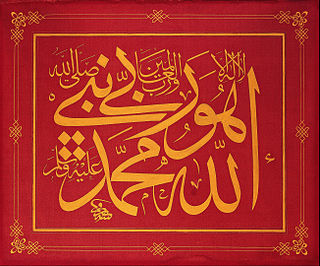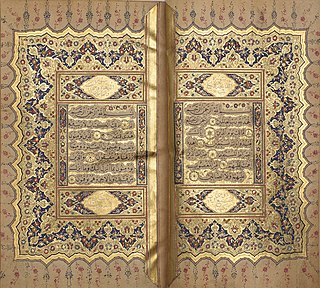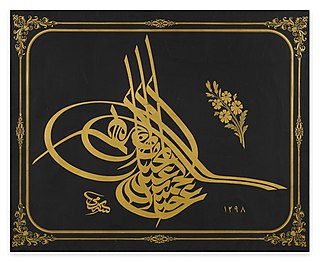Related Research Articles

The Ottoman Turks were a Turkic ethnic group. They founded the Ottoman Empire in the early modern era and remained sociopolitically the most dominant group in the Empire for the duration.
Thuluth is an Arabic script variety of Islamic calligraphy. The straight angular forms of Kufic were replaced in the new script by curved and oblique lines. In Thuluth, one-third of each letter slopes, from which the name comes. An alternative theory to the meaning is that the smallest width of the letter is one third of the widest part. It is an elegant, cursive script, used in medieval times on mosque decorations. Various calligraphic styles evolved from Thuluth through slight changes of form.

Sheikh Hamdullah (1436–1520), born in Amasya, Ottoman Empire, was a master of Islamic calligraphy.
Hattat Aziz Efendi was an Ottoman calligrapher.

Hâfiz Osman (1642–1698) was an Ottoman calligrapher noted for improving the script and for developing a layout template for the hilye which became the classical approach to page design.

The term hilya denotes both a visual form in Ottoman art and a religious genre of Ottoman Turkish literature, each dealing with the physical description of Muhammad. Hilya literally means "ornament".

Mustafa Râkim (1757–1826), was an Ottoman calligrapher. He extended and reformed Hâfiz Osman's style, placing greater emphasis on technical perfection, which broadened the calligraphic art to encompass the Sülüs script as well as the Nesih script.

Ahmed Karahisari (1468–1566) was an Ottoman calligrapher.

İsmail Zühdi Efendi was an Ottoman calligrapher. “Efendi” is a title of nobility, so this name can also be rendered İsmail Zühdi.

Mahmud Celaleddin Efendi was an Ottoman calligrapher.
Kazasker Mustafa Izzet Efendi, was an Ottoman composer, neyzen, poet and statesman best known for his calligraphy.

Mehmed Shevki Efendi was a prominent Ottoman calligrapher. He is known for his Thuluth-Naskh works, and his style developed into the Shevki Mektebi school, which many contemporary calligraphers in the style take as a reference.

Sami Efendi (1858-1912), was an Ottoman calligrapher.

Yesarizade Mustafa Izzet Efendi was an Ottoman calligrapher.
Hamid Aytaç was an Islamic calligrapher born during Ottoman times. In his later life, he was acknowledged as the Islamic world's leading calligrapher and was one of the last of the classical calligraphers.

Esmâ Ibret Hanim was an Ottoman calligrapher and poet, noted as the most successful female calligrapher of her day.

Mustafa Halim Özyazıcı was an Ottoman calligrapher and one of the last of the classic Ottoman calligraphers, using the Arabic script. He was a versatile calligrapher with a high level of expertise in many styles of script, but was widely regarded as a master Jeli Thuluth. He is most noted for his work on various restoration projects, of both manuscripts and public buildings.
Şerife Fatma "Mevhibe" Hanım was a 19th century female Ottoman calligrapher and poet.

The art of Turkish calligraphy dates back to the seventh century. The Ottoman Turks migrated from Central Asia to establish an empire in Anatolia by 1299, and conquered Constantinople in 1453. The Ottoman Empire became a major European power. After the fall of the Mamluk Sultanate (1517), the Ottomans began to exert great influence over Islamic art and placed great emphasis on calligraphy. They collaborated with Egyptian and Persian calligraphers, adopting the naskh and thuluth scripts.
References
- 1 2 3 4 "Prof. Dr. Muhittin Serin - Kubbealtı Akademisi Kültür ve Sanat Vakfı". kubbealti.org.tr. Retrieved 2022-09-30.
- ↑ "Muhittin SERİN". Ministry of Culture and Tourism. 2017.
- ↑ "Hattat Muhittin Serin kimdir? Muhittin Serin hayatı ve eserleri - Ketebe". www.ketebe.org. Retrieved 2022-09-30.